21 gai动词不定式在句子中的功能
- 格式:doc
- 大小:36.50 KB
- 文档页数:3

动词的非谓语形式及其用法详解动词是语言中最基本的词类之一,它用来表示动作、状态或者存在。
除了常见的谓语形式,动词还有一些非谓语形式,包括动词不定式、动名词和分词。
本文将详细介绍这些非谓语形式及其用法。
一、动词不定式动词不定式是动词的一种非谓语形式,一般由“to + 动词原形”构成。
它有以下几种用法:1. 作目的状语:动词不定式可以在句子中充当目的状语,表示动作的目的或目标。
例:I went to the supermarket to buy some groceries.(我去超市买了些杂货。
)2. 作结果状语:动词不定式可以表示动作的结果。
例:She studied hard to pass the exam.(她努力学习以通过考试。
)3. 作目补:动词不定式可以作为某些动词的宾语补语,用来补充说明宾语的内容或者目的。
例:I want to be a doctor.(我想成为一名医生。
)4. 作形容词定语:动词不定式可以修饰名词,充当形容词。
例:He has a book to read.(他有一本可以阅读的书。
)二、动名词动名词是一种由动词构成的名词,通常以-ing结尾。
它有以下几种用法:1. 作主语:动名词可以作为句子的主语。
例:Swimming is my favorite sport.(游泳是我最喜欢的运动。
)2. 作宾语:动名词可以作为及物动词的宾语。
例:She enjoys reading novels.(她喜欢读小说。
)3. 作介词的宾语或介词短语的一部分:动名词可以跟在介词后面,充当介词的宾语或介词短语的一部分。
例:He is good at cooking.(他擅长做饭。
)三、分词分词是一种由动词构成的非谓语形式,根据其形式和用法的不同,分词可以分为现在分词(ing形式)和过去分词(通常以-ed、-en结尾)。
分词有以下几种用法:1. 作定语:分词可以修饰名词,充当形容词。
例:The broken window needs to be repaired.(这扇破损的窗户需要修理。
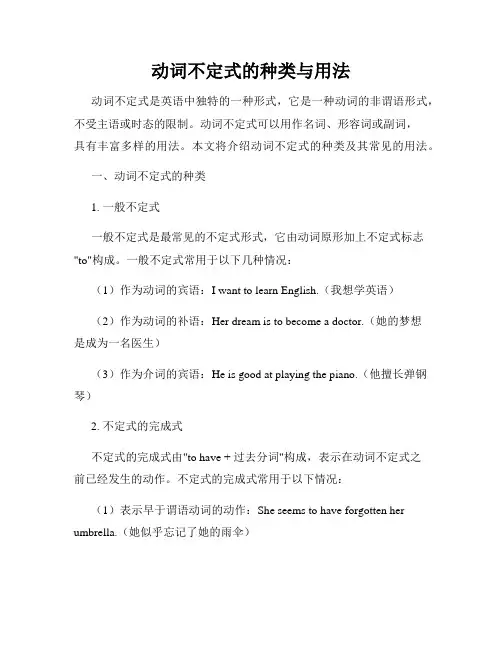
动词不定式的种类与用法动词不定式是英语中独特的一种形式,它是一种动词的非谓语形式,不受主语或时态的限制。
动词不定式可以用作名词、形容词或副词,具有丰富多样的用法。
本文将介绍动词不定式的种类及其常见的用法。
一、动词不定式的种类1. 一般不定式一般不定式是最常见的不定式形式,它由动词原形加上不定式标志"to"构成。
一般不定式常用于以下几种情况:(1)作为动词的宾语:I want to learn English.(我想学英语)(2)作为动词的补语:Her dream is to become a doctor.(她的梦想是成为一名医生)(3)作为介词的宾语:He is good at playing the piano.(他擅长弹钢琴)2. 不定式的完成式不定式的完成式由"to have + 过去分词"构成,表示在动词不定式之前已经发生的动作。
不定式的完成式常用于以下情况:(1)表示早于谓语动词的动作:She seems to have forgotten her umbrella.(她似乎忘记了她的雨伞)(2)表示对动作的猜测或推测:He appears to have lost his way.(他好像迷路了)3. 进行式不定式进行式不定式由"to be + 现在分词"构成,表示动作正在进行。
进行式不定式常用于以下情况:(1)表示将来的动作:I am going to meet my friends at the cinema.(我将要在电影院见我的朋友)(2)表示对现在或过去正在进行的动作的描写:He pretended to be sleeping when I entered the room.(当我进入房间时,他假装正在睡觉)二、动词不定式的用法1. 作主语动词不定式可以作为句子的主语,常见于以下句型:(1)To travel is my dream.(旅行是我的梦想)(2)To learn a new language requires patience.(学习一门新语言需要耐心)2. 作宾语动词不定式可以作为及物动词的宾语,在句中起到说明动作的目的或结果的作用,常见于以下句型:(1)She wants to become a teacher.(她想成为一名老师)(2)I need to buy some groceries.(我需要买一些杂货)3. 作定语动词不定式可以作为形容词的定语,修饰名词或代词,常见于以下句型:(1)The best way to learn is to practice.(学习的最佳方法是实践)(2)He gave me a book to read.(他给我一本书来阅读)4. 作状语动词不定式可以作为副词的状语,修饰动词、形容词或副词,常见于以下句型:(1)He went to the library to study.(他去图书馆学习)(2)She is too young to drive.(她太年轻不能开车)总结:动词不定式有一般不定式、不定式的完成式和进行式不定式等种类。
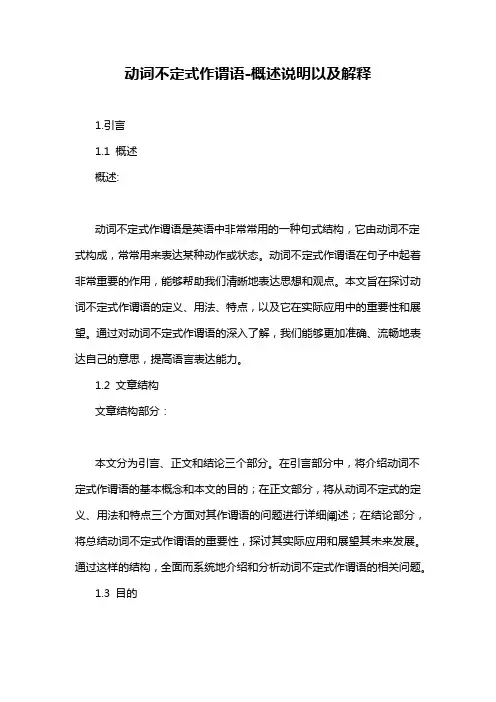
动词不定式作谓语-概述说明以及解释1.引言1.1 概述概述:动词不定式作谓语是英语中非常常用的一种句式结构,它由动词不定式构成,常常用来表达某种动作或状态。
动词不定式作谓语在句子中起着非常重要的作用,能够帮助我们清晰地表达思想和观点。
本文旨在探讨动词不定式作谓语的定义、用法、特点,以及它在实际应用中的重要性和展望。
通过对动词不定式作谓语的深入了解,我们能够更加准确、流畅地表达自己的意思,提高语言表达能力。
1.2 文章结构文章结构部分:本文分为引言、正文和结论三个部分。
在引言部分中,将介绍动词不定式作谓语的基本概念和本文的目的;在正文部分,将从动词不定式的定义、用法和特点三个方面对其作谓语的问题进行详细阐述;在结论部分,将总结动词不定式作谓语的重要性,探讨其实际应用和展望其未来发展。
通过这样的结构,全面而系统地介绍和分析动词不定式作谓语的相关问题。
1.3 目的本文的目的是探讨动词不定式作为谓语的用法和特点。
通过对动词不定式的定义、用法和特点进行分析,我们旨在帮助读者更好地理解动词不定式在句子中的作用,以及其在表达意思和语法结构上的重要性。
同时,我们也将探讨动词不定式作谓语在实际应用中的具体案例,以及未来在语言运用中的可能发展趋势。
通过本文的研究,希望读者能够更加灵活地运用动词不定式作为谓语,提高语言表达的准确性和丰富性。
2.正文2.1 动词不定式的定义动词不定式是指由动词原形加上不定式标志“to”构成的动词形式,如to run, to eat等。
动词不定式可以作为句子的谓语,通常放在主语之后,用来表示主语的动作或状态。
在句子中,动词不定式可以作为及物动词的宾语,也可以作为介词的宾语。
动词不定式的形式固定,不受人称和数的变化,但有时可以有进行时和完成时的形式。
动词不定式是英语中一种非常重要的句子成分,它可以表达各种各样的含义,包括目的、意图、目标、动机等。
在句子中,动词不定式可以单独出现,也可以与其他词语组成不同的句子结构,例如不定式短语、不定式从句等。

动词不定式的用法总结动词不定式是英语中一种常见的非谓语动词形式,由动词原形加上“to”构成。
它具有多种用法和功能,在句子中可以扮演多种角色。
下面将对动词不定式的用法进行总结和分析。
一、作主语动词不定式可以作为句子的主语,通常位于句首,帮助构成句子的基本结构。
例如:- To learn is to grow. - To study is important for success.二、作宾语动词不定式可以作为动词的宾语,跟在及物动词之后。
例如:- She wants to dance all night. - They decided to go on a trip.三、作介词宾语动词不定式还可以作为介词的宾语,通常介词后面要跟动词的-ing形式,但在某些情况下,使用动词不定式更为恰当。
例如:- She is afraid to speak in public. (介词“in”后接动词不定式) - He is capable of solving difficult problems. (介词“of”后接动词不定式)四、作定语动词不定式可以作为名词的定语,修饰名词。
例如:- I have some books to read. - This is a place to visit.五、作表语动词不定式有时也可以作为句子的表语,描述主语的身份或状态。
例如:- His goal is to become a doctor. - The key is to be patient.六、作宾补动词不定式可以作为宾语的补语,表示对宾语的补充说明。
例如:- She considers him to be her best friend. - They found the task to be challenging.七、作状语动词不定式还可以作为状语,修饰动词或整个句子,表示目的、原因、结果等。
例如:- She works hard to achieve her goals. (目的) - He left early to catch the train. (目的) - He stayed up late to finish his project. (目的) - He left the room, only to return a few moments later. (结果)动词不定式的用法多样灵活,在句子中起着重要的作用。
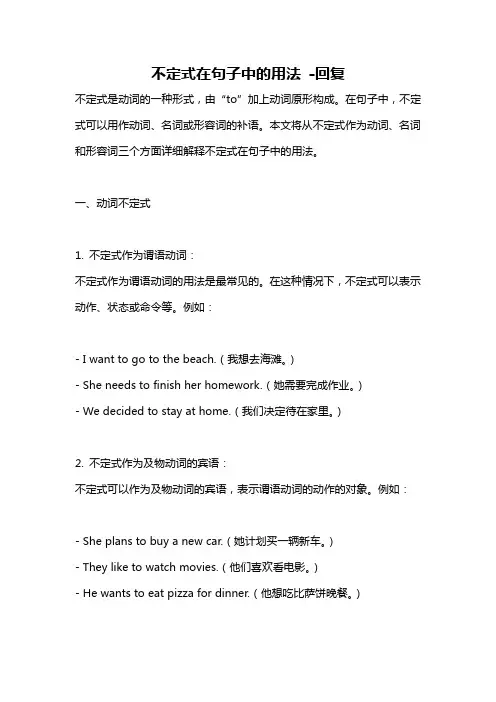
不定式在句子中的用法-回复不定式是动词的一种形式,由“to”加上动词原形构成。
在句子中,不定式可以用作动词、名词或形容词的补语。
本文将从不定式作为动词、名词和形容词三个方面详细解释不定式在句子中的用法。
一、动词不定式1. 不定式作为谓语动词:不定式作为谓语动词的用法是最常见的。
在这种情况下,不定式可以表示动作、状态或命令等。
例如:- I want to go to the beach.(我想去海滩。
)- She needs to finish her homework.(她需要完成作业。
)- We decided to stay at home.(我们决定待在家里。
)2. 不定式作为及物动词的宾语:不定式可以作为及物动词的宾语,表示谓语动词的动作的对象。
例如:- She plans to buy a new car.(她计划买一辆新车。
)- They like to watch movies.(他们喜欢看电影。
)- He wants to eat pizza for dinner.(他想吃比萨饼晚餐。
)3. 不定式作为不及物动词的宾语:不定式也可以作为不及物动词的宾语,表示动作的方向或目标。
例如:- I learned to swim last summer.(去年夏天我学会了游泳。
)- She practiced to dance every day.(她每天练习跳舞。
)- He tries to run faster.(他试着跑得更快。
)4. 不定式作为状语:不定式可以作为状语修饰谓语动词,表示目的、结果、方式等。
例如:- We went to the supermarket to buy some groceries.(我们去超市买一些杂货。
)- She studied hard to get good grades.(她努力学习以获得好成绩。
)- He spoke softly to avoid waking up the baby.(他小声说话以免吵醒婴儿。

三大非谓语动词的语法作用非谓语动词主要包括不定式、动名词和分词(现在分词和过去分词)三种形式。
以下是三大非谓语动词的语法作用:1. 不定式:不定式在句子中可以作为主语、宾语、表语、定语和状语。
作主语:To see is to believe(眼见为实)。
作宾语:I want to go home(我想回家)。
作表语:My dream is to become a teacher(我的梦想是成为一名老师)。
作定语:I have a lot of homework to do(我有很多作业要做)。
作状语:I came here to see you(我来这里看你)。
2. 动名词:动名词在句子中可以作为主语、宾语和表语。
作主语:Reading books is a good habit(读书是一个好习惯)。
作宾语:I enjoy listening to music(我喜欢听音乐)。
作表语:My hobby is playing basketball(我的爱好是打篮球)。
3. 分词:分词在句子中可以作为定语、表语、状语和补足语。
作定语:The excited children were running around the playground (兴奋的孩子们在操场上跑来跑去)。
作表语:I feel bored(我觉得无聊)。
作状语:He went to the library, following his teacher(他跟着老师去了图书馆)。
作补足语:We found the missing child crying in the woods(我们找到了在树林里哭的失踪孩子)。
总的来说,非谓语动词在句子中有着重要的语法作用,可以使句子结构更加丰富,表达更加多样。
如需了解更多关于非谓语动词的信息,建议查阅英语语法书籍或咨询英语教师。
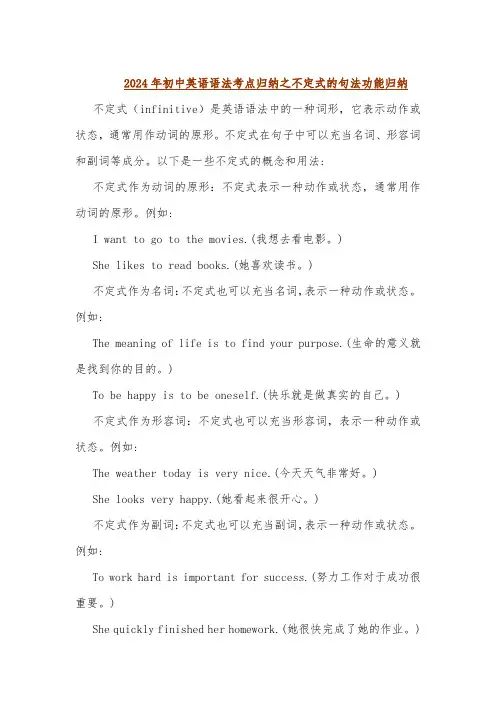
2024年初中英语语法考点归纳之不定式的句法功能归纳不定式(infinitive)是英语语法中的一种词形,它表示动作或状态,通常用作动词的原形。
不定式在句子中可以充当名词、形容词和副词等成分。
以下是一些不定式的概念和用法:不定式作为动词的原形:不定式表示一种动作或状态,通常用作动词的原形。
例如:I want to go to the movies.(我想去看电影。
)She likes to read books.(她喜欢读书。
)不定式作为名词:不定式也可以充当名词,表示一种动作或状态。
例如:The meaning of life is to find your purpose.(生命的意义就是找到你的目的。
)To be happy is to be oneself.(快乐就是做真实的自己。
)不定式作为形容词:不定式也可以充当形容词,表示一种动作或状态。
例如:The weather today is very nice.(今天天气非常好。
)She looks very happy.(她看起来很开心。
)不定式作为副词:不定式也可以充当副词,表示一种动作或状态。
例如:To work hard is important for success.(努力工作对于成功很重要。
)She quickly finished her homework.(她很快完成了她的作业。
)不定式省略to的六种情况一、使役动词后省略to的情况使役动词是一类表示动作或状态由主语执行的动词。
在英语中,使役动词后面通常接不定式结构to + 宾语,表示主语执行该动作或状态。
但是,在某些情况下,使役动词后面可以省略to,直接使用主语+动词的结构。
以下是一些使役动词后省略to的情况:当使役动词为感官动词时,例如see、hear、feel等,后面的宾语可以是名词或代词。
在这种情况下,使役动词后面可以省略to,直接使用主语+动词的结构。
例如:I can't see my cat.(我看不见我的猫。

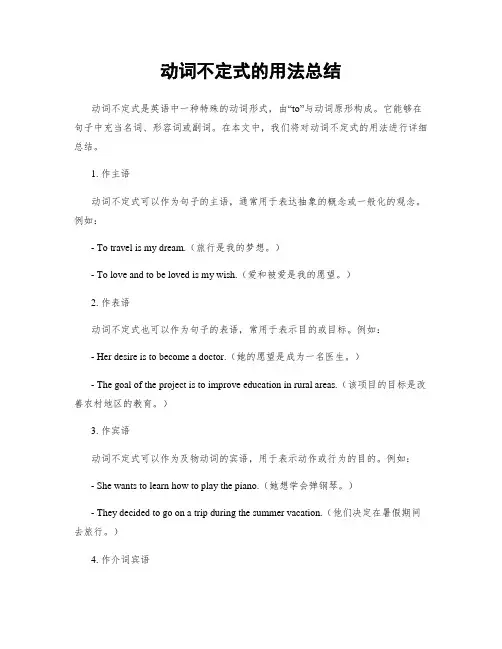
动词不定式的用法总结动词不定式是英语中一种特殊的动词形式,由“to”与动词原形构成。
它能够在句子中充当名词、形容词或副词。
在本文中,我们将对动词不定式的用法进行详细总结。
1. 作主语动词不定式可以作为句子的主语,通常用于表达抽象的概念或一般化的观念。
例如:- To travel is my dream.(旅行是我的梦想。
)- To love and to be loved is my wish.(爱和被爱是我的愿望。
)2. 作表语动词不定式也可以作为句子的表语,常用于表示目的或目标。
例如:- Her desire is to become a doctor.(她的愿望是成为一名医生。
)- The goal of the project is to improve education in rural areas.(该项目的目标是改善农村地区的教育。
)3. 作宾语动词不定式可以作为及物动词的宾语,用于表示动作或行为的目的。
例如:- She wants to learn how to play the piano.(她想学会弹钢琴。
)- They decided to go on a trip during the summer vacation.(他们决定在暑假期间去旅行。
)4. 作介词宾语动词不定式可以作为介词的宾语,用于表示介词所描述的动作或状态。
例如:- He asked me to help him with his homework.(他要求我帮助他做作业。
)- They are looking forward to meeting their friends at the party.(他们期待在派对上和朋友们见面。
)5. 作定语动词不定式可以作为名词的定语,用于修饰名词并描述其用途或目的。
例如:- She needs a pen to write down the important information.(她需要一支笔来记下重要的信息。

(完整版)动词不定式用法小结动词不定式用法动词不定式没有人称和数的变化,在句中不能独立作谓语。
但动词不定式具有名词、形容词和副词特征,在句中可以作主语、宾语、宾语补足语、定语、表语和状语等多种成分。
另外,动词不定式具有动词特点,可以有自己的宾语和状语,组成动词不定式短语。
动词不定式的肯定形式是to+do;其否定形式是not to+do。
下面以动词不定式在句中的作用来予以详细说明。
1.作主语可以直接作主语。
如:To see is to believe.但在英语中,常用it作形式主语,真正的主语即动词不定式放在后面。
如:It's wrong to play tricks on other people.It's our duty to keep our environment clean and tidy.点击规律:动词不定式在句中作主语时,常放在It is +adj.(形容词)+to do sth.或It is +n.(名词)+to do sth.句型中,it 仅作形式主语。
2.作宾语a.want,decide ,agree等动词后面跟并且只能跟不定式。
如:We agreed to start early.She wants to be a doctor.b.love,like ,begin,start,hate ,prefer等词后面可以接不定式。
点击规律:上述动词后面除接不定式外,还可以接动名词,意思无很大区别。
提示板:like doing指经常性动作,而like to do指一次性的动作。
如:I like swimming,but I don't like to swim now.我喜欢游泳,但我现在不想游。
c.stop,forget,remember,go on ,try等词或短语后面可以接不定式。
点击规律:上述动词后面接不定式和接动名词意思大不相同。
提示板:1)stop to do sth.:停止一件事,去做另一件事。
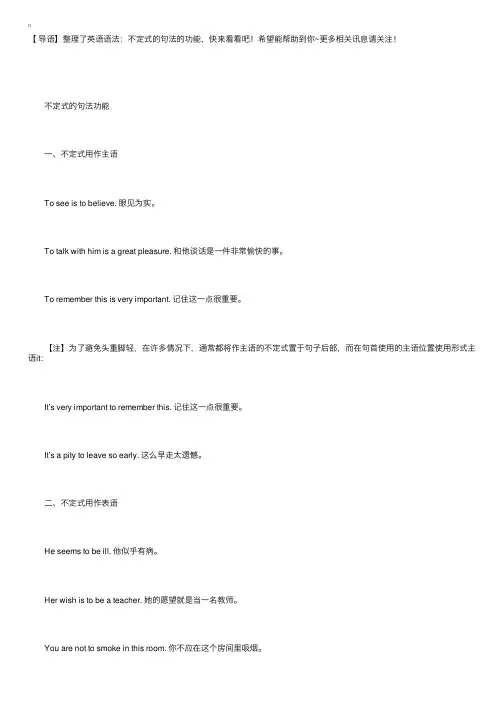
【导语】整理了英语语法:不定式的句法的功能,快来看看吧!希望能帮助到你~更多相关讯息请关注! 不定式的句法功能 ⼀、不定式⽤作主语 To see is to believe. 眼见为实。
To talk with him is a great pleasure. 和他谈话是⼀件⾮常愉快的事。
To remember this is very important. 记住这⼀点很重要。
【注】为了避免头重脚轻,在许多情况下,通常都将作主语的不定式置于句⼦后部,⽽在句⾸使⽤的主语位置使⽤形式主语it: It’s very important to remember this. 记住这⼀点很重要。
It’s a pity to leave so early. 这么早⾛太遗憾。
⼆、不定式⽤作表语 He seems to be ill. 他似乎有病。
Her wish is to be a teacher. 她的愿望就是当⼀名教师。
You are not to smoke in this room. 你不应在这个房间⾥吸烟。
【注】不定式作表语主要有三种情况,⼀是⽤于seem, appear, prove, turn out等连系动词之后的不定式(尤其是to be),⼆是像My job is to sweep the floor(我的⼯作就是擦地板)这样的主语与表语“等价”的情形,三是表⽰想法、约定、义务、命令、可能性、命运等,再如: We are to meet at the station at three. 我们约定3点钟在车站见⾯。
(表约定) How are we to convince him? 我们怎么能说服他呢? (表可能性) You are to come when I call. 叫你来的时候,你必须来。
(表命令) 三、不定式⽤作宾语 I can’t afford to buy a car. 我买不起汽车。
不定式的句法功能归纳不定式虽然不能做谓语,但保留着动词的特征,可带有自己的宾语和状语,从而形成不定式短语。
不定式短语具有名词、形容词及副词的性质,可做主语、宾语、宾语补足语、表语、同位语、定语及状语等句子成分。
一、不定式做主语(1)英语中,不定式短语可放在句首充当句子的主语。
如:To learn English well is very important. 学好英语很重要。
(2)但为了使句子平衡,常用it做形式主语放在句首,而将真正的主语——不定式放到句末,特别是在疑问句及感叹句中必须采用这种方式。
如:It is very important to learn English well. 学好英语很重要。
Is it necessary to bring an umbrella today? 今天带雨伞有必要吗?(3)不定式做主语时,不能有单独的名词或代词做逻辑主语,而应用for sb. /of sb. 做它的逻辑主语,当不定式表示对逻辑主语的利害关系时,用for sb;当不定式用来对逻辑主语表示赞美或责备时,用of sb。
如:It is not good for your eye to read in the sun. 在阳光下看对你的眼睛不好。
It is very kind of you to help us. 你来帮助我们,真是太好了。
二、不定式做宾语(1)在英语中,不定式可用来做宾语。
如:He agrees to go with us. 他同意跟我们一起去。
I want to buy a Chinese-English dictionary. 我想买一本汉英词典。
(2)不定式做宾语时须注意:A.不定式并不是可做任何及物动词的宾语。
能接不定式做宾语的动词有:afford, agree, arrange, ask, attempt, begin, care, choose, continue, dare, decide, desire, demand, determine, elect, expect, fail, hate, hesitate, hope, intend, know, learn, like, long, love, manage, mean, need, offer, plan, prepare, promise, pretend, prefer, refuse, require, start, try, wait, want, wish, wonder. 如:I can’t afford to buy such an expensive computer. 我买不起这么昂贵的电脑。
动词不定式的语法作用动词不定式,听起来就有点复杂,其实它在我们的日常生活中无处不在。
比如说,你想要吃一块蛋糕,嘴里喊着“我想要”,这就是在用动词不定式啦。
想想看,动词不定式就像是那块美味的蛋糕,让人忍不住想要一口。
不定式的形式很简单,通常是“to +动词原形”,这样说来,简单吧?我们每天都会用到。
在英语中,动词不定式可真是个百搭的家伙。
它可以充当主语、宾语、表语,甚至是修饰成分。
想象一下,走在路上,看到一个小孩指着天空,兴奋地说:“我想飞!”这里的“飞”就是动词不定式,完美地表达了小孩的梦想。
又比如说,“读书是快乐的”,这里的“读书”其实就是“to read”的一种变体,听起来更文艺一些,对吧?我们常常在生活中不知不觉就用上了它。
再说说动词不定式的魅力,尤其是在表达目的和意图的时候。
比如你去超市,心里想着“我去买牛奶”。
这里的“买”其实就是动词不定式的应用,简单明了,没啥负担。
你可以用动词不定式来说明你想要实现的目标,像“我想学英语”,这是多么直接又清晰的表达。
语言嘛,有时候就是这么直接有效,让人一听就明白。
动词不定式还可以让你的句子变得更加生动。
比如说,“我喜欢旅行”,可以升级为“我喜欢去旅行”,是不是听起来更有劲儿?这种变化让人觉得你对生活的热爱跃然纸上,让人忍不住想要和你一起去探索世界。
语言的魅力就在于此,不定式让表达变得更加丰富多彩。
不仅如此,动词不定式还可以和其他词结合,形成各种有趣的短语。
比如说,“决定去做某事”,这里的“去做”就是动词不定式的魅力所在。
你可能会想,“那这和我有什么关系呢?”动词不定式就在我们身边,影响着我们说话的方式、思考的习惯。
无论是小孩的梦想,还是成年人工作的目标,动词不定式都是不可或缺的元素。
让我们来聊聊那些带有感情色彩的表达。
像“我希望能实现梦想”,这里的“实现”也是动词不定式,透着满满的期望和愿景。
这样的句子让人觉得温暖,仿佛在说:“嘿,我也有梦想呢!”这就是语言的力量,它能够拉近人们的距离,让彼此感同身受。
动词不定式的用法初中语法规则动词不定式是指不带主语,含有不定式符号“to”的动词形式。
在英语语法中,动词不定式有着重要的用法和作用。
本文将介绍初中语法规则中关于动词不定式的用法。
一、作主语:动词不定式可以作为句子的主语,常常出现在句子的开头。
例如:To learn a foreign language is beneficial for young students.学一门外语对年轻学生来说是有益的。
二、作宾语:动词不定式可以作为及物动词的宾语。
例如:I want to visit my grandparents next week.我下周想去探望我的祖父母。
三、作介词的宾语:某些介词后面必须使用动词不定式作宾语,在不定式前加适当的介词。
例如:I am good at playing the piano.我擅长弹钢琴。
四、作定语:动词不定式可以作为名词前的定语来修饰名词。
例如:It's important to have a healthy lifestyle.保持健康的生活方式很重要。
五、作补语:某些动词后面可以跟动词不定式作补语。
例如:She made me laugh out loud.她让我笑得很大声。
六、作状语:动词不定式可以作为句子的状语,表示目的、结果、原因、方式等。
例如:He ran fast to catch the bus.他跑得很快,为的是赶上公车。
七、作形容词的补语:动词不定式可以作为形容词的补语,补充说明主语的状态或特征。
例如:I am pleased to meet you.很高兴见到你。
八、作名词的补语:某些名词后面可以跟动词不定式作补语。
例如:It's my dream to become a writer.成为一名作家是我的梦想。
九、作感叹句的主语或补语:动词不定式可以作为感叹句的主语或补语。
例如:To win the competition is so exciting!赢得比赛太令人兴奋了!综上所述,动词不定式在初中语法规则中有着多种重要的用法。
高中英语动词不定式语法总结一、动词不定式的定义和特点动词不定式是英语语法中的一种重要形式,用于表示一个将要发生或尚未发生的动作。
它具有名词、形容词和副词的特征,可以作为句子中的独立成分,与句子中的其他成分保持语法和语义的连贯性。
二、动词不定式的时态和语态1. 时态:动词不定式可以有不同的时态形式,包括一般式、进行式和完成式。
例如,不定式的一般式表示一个一般性的动作;不定式的完成式表示一个已完成的动作,发生在句子谓语动词之前。
2. 语态:动词不定式可以有被动语态形式,表示一个动作由他人或某物所导致。
三、动词不定式的复合结构动词不定式可以有自己的复合结构,即“名词所有格”或“动词-ing”形式加上“to do”。
这些结构可以作主语、宾语、表语等,与句子的主语形成语法上的关系。
四、动词不定式的句法功能动词不定式可以在句中充当各种句法成分,如主语、宾语、表语、定语等。
同时,它可以与一些词类连用,如形容词、副词、介词短语等。
五、常用动词不定式短语和结构1. it + 形容词/ 名词 + 不定式结构:表示将来的计划或情况。
2. be + 形容词 + to do:表示某人愿意或想要做某事。
3.感官动词 + 不定式结构:表示一种观察或感受。
4. 疑问词 + 不定式结构:可以用于询问目的或意图。
5. 介词 + 名词/ 动名词 + to do:表示一种方式或手段。
六、动词不定式的否定形式动词不定式的否定形式是在不定式符号前加上“not”。
同时,有一些特殊的否定结构,如“hardly/ scarcely + 否定词+ to do”、“not so much to do as to do”等。
七、动词不定式的疑问形式动词不定式的疑问形式是将疑问词直接放在不定式符号前,构成一个疑问句。
常见的疑问词有who/ what/ which/ how/ when/ where等。
八、动词不定式的省略形式在某些情况下,动词不定式可以省略,特别是在一些固定短语中。
不定式在句子中的用法一、不定式的概念和构成不定式,作为英语语法中的一种非谓语动词形式,用于表示动作或状态。
不定式由动词原形加不定式符号to构成,具有动词的特征,同时又没有时态、语态和人称的变化。
二、不定式的句法功能1.作主语:To learn a foreign language is challenging. (学习一门外语是具有挑战性的。
)2.作宾语:She prefers to study at home rather than go to the library. (她更喜欢在家学习而不是去图书馆。
)3.作表语:The real reason for his absence was to take care of his sick mother. (他缺席的真正原因是照顾生病的母亲。
)4.作定语:I have a lot of homework to do. (我有很多家庭作业要做。
)5.作状语:To be honest, I don't like the idea. (说实话,我不喜欢这个主意。
)三、不定式的否定形式不定式的否定形式是在不定式前加上not或never。
例如:I decided not to go to the party. (我决定不去参加派对。
)四、不定式的时态和语态1.一般式:I am glad to see you. (很高兴见到你。
)2.进行式:He pretended not to be listening to our conversation. (他假装没有在听我们说话。
)3.完成式:I regret not having taken your advice. (我很遗憾没有听从你的建议。
)4.被动式:The book is not likely to be published. (这本书不太可能出版。
)五、不定式的逻辑主语表示法当不定式的动作或状态与句子主语不一致时,需要使用逻辑主语来表示这个动作或状态是谁执行的。
动词不定式在句子中的功能
山东省日照市东港区南湖中心初中 刘 锐 276817
rzliurui@sina.com rzliurui2010@126.com
动词不定式的用法在初中教科书中作过小结,本单元进一步介绍它在句子中可
担任哪些成分。不定式作为英语非谓语动词中的一种,兼有类似于名词、形容词和
副词的功能,同时也保留着动词的性能,所以可在句子中担任多种成分:
1)主语:To serve the people is my wish.
To learn from each other is important.
To get there took five hours.
不定式作句子的主语时,常用形式主语it引出:上几句可改为
It is a pleasure to meet you.
It is important to learn from each other.
It took five hours to get there.
It is necessary to use a short-wave radio. (=To use a short-wave radio
is necessary.) 使用一台短波收音机是必要的。
It is not difficult to find out information about the programme. (=To find
out information about the programme is not difficult.)
查询有关节目的情况并不难。
It is necessary to ask her for help. (=To ask her for help is necessary.)
要求她帮忙是必要的。
It is our duty to help poor people. (To help poor people is our duty.)
帮助穷人是我们的责任。
通过以上例句,我们可以归纳以下三点:
a)it在句中是形式主语,而真正的主语是句子后部的不定式或不定式短语(to
do sth.)。
b)当这个不定式很短的时候,可以把这个不定式放在主语的位置,而无需借助
于形式主语。如:
It is easy to do, but it is difficult to understand. =To do is easy, but to
understand is difficult. 知难行易。
c)但是,如果做主语的不定式短语较长,则通常采用形式主语it,而真正的
主语置于句尾,以避免“头重脚轻”的现象。
2)宾语:They don’t like to be too close to one another.
I don’t know what to do.
He can’t tell how to get to the station.
不定式常在下述及物动词后面作宾语:want, wish, hope, manage, ask, offer,
promise, pretend, attempt, decide, learn, agree, choose, determine, expect等。在help后
面做宾语时,动词不定式可以不带to:
I think I can help (to) write two chapters.
当不定式后面还有宾语补语时,常用形式宾语it引出不定式:
They found it impossible to get ready in time. (impossible是宾语补语)
3) 宾语补语:Would you like me to do something for you?
不定式常在下述及物动词后面作宾语补语:ask, tell, invite, force, beg, get, wish,
want, hate, prefer, expect, encourage, advise, persuade, instruct, permit, remind, request,
order, command, warn, cause等。此外,在某些动词后面,用不带to的不定式作宾语
补语:make, have, let, see, hear, watch, notice, feel等。例如:
They made him work twelve hours a day.
I heard her enter the next room.
I asked her to come out with me for the evening.
She wanted me to call her at six. 他让我六点钟打电话给他。
Tell him to wait. 教他瞪着
Let me try. 让我试试。
Did you see him go out. 你看见他出去了吗?
Two policemen helped Mr Brown (to) get out. 两个警察帮助布朗先生下车。
4)状语:They will move back to keep a certain distance away.
不定式可作多种状语,例如:
目的:He came to help us. 他来帮组我们。
I sat in the front row in order / so as to see well.我站在前排以便看的跟好。
Sometimes Susan goes home to lunch. 有时苏珊回家吃午饭。
结果:I arrived at the station only to find the train had left.
我到达车站发现车已经离开了。
He is old enough to dress himself. 他已经够大了可以自己穿衣服了。
原因:I’m glad to meet you. 我非常高兴遇见你。
To cool the hot dish, Mrs Wilson put it near the open window.
为了冷却那盘热菜,威尔逊夫人把它放在开着的窗子附近。
5)表语:Waving one’s hand is to say “Goodbye”.
不定式作表语,出现在系动词之后。又如:
Our aim is to improve our spoken English.
You seem to know everyone here.
6)定语:Have you got anything to say?
不定式作定语,初学者往往不会辨认。下面是几种辨认方法:
a. 不定式常在一些特定的句式中作定语,例如:
She has a meeting to attend.
There is something else to do.
He was the first to come to school.
This is the only thing to do at present.
We need someone to help us out.
b. 不定式也常在一些特定的名词后作定语,如time, way, turn, chance, courage,
wish, reason, effort, decision, need, right等。例如:
It’s your turn to recite the text.
You have no right to read my letter.
c. 不定式描述某名词的用途时,也是定语。例如:
Can you give me a box to hold my books?
7) “疑问词 + 不定式 ”结构
疑问代词what who which 和疑问副词 when where how 等后加不定式,这
种结构具有名词的功能,在句中常作宾雨,也可作主语或主语补语。例如:
宾语:I don’t know what to do. 我不知道要做什么。
He can’t tell how to get to the station. 它补知道怎样到火车站。
主语: When to start has not been decided. 何时动身尚未决定。
主语补语: The question is which to keep. 问题是保留哪些。